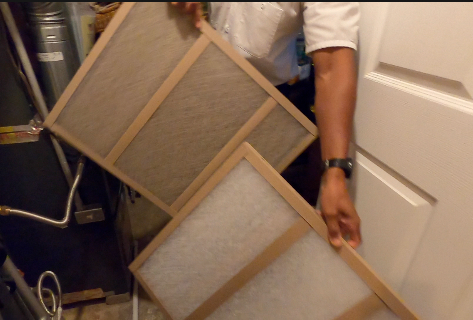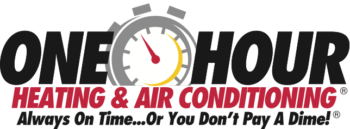As the chill of winter begins to thaw and the promise of warmer days looms on the horizon, we Kansas Citians are gearing up for the transition from heating to cooling. However, the change in seasons can sometimes reveal issues with HVAC systems that lay dormant during the colder months.
If your furnace or air conditioner is not working properly, here are some common problems that residents in our area may face in early spring. We’ll also provide tips on how to fix them!
Clogged Air Filters:

The most problem we see is clogged air filters. Over the winter months, dust, dirt, and other debris accumulates in the filters. This reduces airflow and makes the system work harder to heat or cool the home.
Solution: Regularly check and replace your air filter to ensure optimal airflow and energy efficiency.
Thermostat Malfunctions:
Fluctuating temperatures in early spring can sometimes cause thermostat malfunctions, leading to inconsistent heating or cooling in the home.
Easy Fixes for Thermostat Problems:
- Check Power Source: Begin troubleshooting by ensuring that the thermostat has power. If it’s battery-operated, replace the batteries with fresh ones. For hardwired thermostats, check the circuit breaker to ensure there’s power to the HVAC system.
- Clean and Calibrate: Dust and debris accumulation can affect the accuracy of temperature readings. Use a soft brush or compressed air to clean the thermostat’s interior components gently. Additionally, some thermostats may need recalibration to ensure accurate temperature readings.
- Verify Settings: Double-check the thermostat settings to ensure they are correctly configured for heating or cooling mode, depending on the weather. Also, check the fan settings to ensure they are set to the desired mode (auto or on).
- Check for Obstructions: Ensure that the thermostat is not obstructed by any objects that could interfere with its temperature readings, such as curtains, furniture, or electronic devices.
When to Call a Professional: While some thermostat issues can be resolved with simple troubleshooting steps, usually you’ll want a professional to handle your thermostat problem. Consider calling a HVAC technician if:
- The thermostat continues to display incorrect temperature readings or fails to respond after troubleshooting steps have been attempted.
- There are signs of wiring issues, such as exposed wires, loose connections, or burnt components.
- The HVAC system fails to turn on or maintain the desired temperature despite proper thermostat settings and troubleshooting efforts.
- The thermostat is outdated or malfunctioning and requires replacement or upgrades.
Refrigerant Leaks:
Refrigerant plays a crucial role in the cooling process of your HVAC system. It absorbs heat from the indoor air and transfers it outside. However, refrigerant leaks disrupt this process, and lead to diminished cooling. Below are some symptoms of refrigerant leaks and how to address them effectively.
Symptoms of Refrigerant Leaks:
- Reduced Cooling: One of the primary indicators of a refrigerant leak is a noticeable decrease in the cooling performance of your HVAC system. If your air conditioner struggles to maintain the desired temperature despite regular operation, it could be due to insufficient refrigerant levels caused by a leak.
- Warm Air Blowing from Vents: When refrigerant levels are low due to a leak, the air blowing from your vents may feel warmer than usual. This occurs because the refrigerant is unable to absorb and transfer heat effectively, resulting in compromised cooling efficiency.
- Ice Buildup on Refrigerant Lines: Another visible sign of a refrigerant leak is the formation of ice or frost on the refrigerant lines or evaporator coil of your air conditioner. Low refrigerant levels can cause the remaining refrigerant to expand rapidly, leading to condensation and freezing of moisture on the components.
- Hissing or Bubbling Sounds: In some cases, you may hear hissing or bubbling sounds coming from your HVAC system, particularly near the indoor or outdoor unit. These noises can indicate the presence of a refrigerant leak, as the escaping gas creates pressure changes within the system.
- Elevated Energy Bills: A refrigerant leak can force your HVAC system to work harder to achieve the desired level of cooling, resulting in increased energy consumption and higher utility bills. If you notice a sudden spike in your energy costs without a corresponding increase in usage, it could be due to a refrigerant leak.
Steps to Address Refrigerant Leaks:
Schedule a Professional Inspection: If you suspect a refrigerant leak based on the symptoms mentioned above, it’s crucial to contact a qualified HVAC technician to conduct a thorough inspection of your system. HVAC Technicians with One Hour Heating and Air Conditioning use specialized tools and techniques to detect the location and severity of the leak.
Refrigerant leaks in your HVAC system can compromise its efficiency and lead to costly repairs if left unaddressed.
If you suspect a refrigerant leak, contact a professional HVAC technician to inspect and repair the issue. Attempting to handle refrigerant without proper training and equipment can be dangerous and may result in further damage to the system.
Outdoor Unit Blockages:
After months of inactivity, the outdoor unit of an HVAC system may become blocked by debris such as leaves, branches, or dirt. This can restrict airflow and hinder the system’s ability to operate efficiently.
Solution: Clear any debris from the outdoor unit and ensure that it has adequate space for proper airflow. Trim vegetation around the unit to prevent future blockages and maintain optimal performance.
Ductwork Leaks:
Leaks or gaps in the ductwork can lead to wasted energy and reduced indoor comfort as conditioned air escapes into unconditioned spaces such as attics or crawlspaces.
Leaks in ductwork can occur due to various factors, including poor installation, aging ducts, or damage from pests or environmental factors. These leaks allow conditioned air to escape into unconditioned spaces, such as attics or crawl spaces, resulting in energy waste and decreased system efficiency. Additionally, leaks can introduce contaminants, such as dust, allergens, and pollutants, into the indoor air, compromising air quality and exacerbating respiratory issues.
The Aeroseal Solution:

Aeroseal duct sealing (a service by One Hour Heating and Air Conditioning) offers a unique and highly effective approach to addressing leaking ductwork. Unlike traditional methods that rely on manual sealing techniques, Aeroseal utilizes a patented aerosol-based sealing process to target and seal leaks from the inside out. Here’s how it works:
- Pre-Seal Assessment: A certified Aeroseal technician begins by conducting a thorough assessment of your ductwork system using advanced diagnostic tools. This assessment helps identify the location and extent of leaks within the ducts.
- Sealing Process: Once the assessment is complete, the technician prepares the ductwork system for sealing by blocking off vents and registers. They then inject Aeroseal sealant particles into the ducts, which are carried by airflow to the site of leaks.
- Targeted Sealing: The Aeroseal particles accumulate at the edges of leaks, where they bond together and form a durable seal. This process continues until the majority of leaks are effectively sealed, with minimal wastage of sealant.
- Verification: After sealing is complete, the technician conducts post-seal diagnostics to verify the effectiveness of the process. This may include airflow testing and measuring pressure differentials to ensure that leaks have been adequately addressed.
Benefits of Duct Sealing:
- Improved Energy Efficiency: By sealing leaks in the ductwork, Aeroseal helps prevent conditioned air from escaping, reducing energy waste and lowering utility bills.
- Enhanced Comfort: Sealed ductwork ensures more consistent airflow throughout your home, eliminating hot or cold spots and providing greater comfort year-round.
- Better Indoor Air Quality: Aeroseal helps prevent the infiltration of pollutants and allergens into the ductwork, improving indoor air quality and promoting a healthier living environment.
- Long-lasting Results: The durable seal created by Aeroseal is designed to last for years, providing lasting benefits without the need for frequent maintenance or resealing.
Leaking ductwork can significantly impact the performance and efficiency of your HVAC system, leading to wasted energy and compromised comfort. duct sealing offers a cutting-edge solution to this problem, effectively sealing leaks and optimizing the performance of your ductwork system. By investing in Aeroseal duct sealing, homeowners can enjoy improved energy efficiency, enhanced comfort, and better indoor air quality for years to come.
As spring arrives in Kansas City, it’s essential for homeowners to be proactive in addressing common HVAC problems that may arise during the transition from winter to warmer weather. By staying vigilant, performing regular maintenance, and seeking professional help when needed, residents can ensure that their HVAC systems operate efficiently and reliably throughout the changing seasons.
